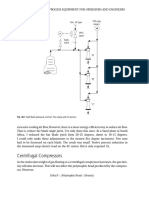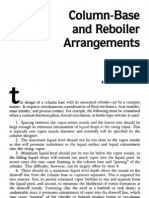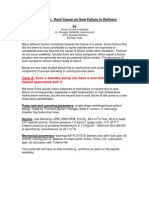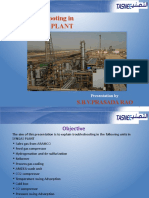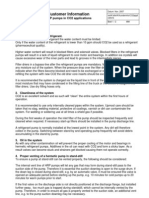0 ratings0% found this document useful (0 votes)
116 viewsPump Cavitation Caused by Entrained Gas: Plant Safety and Environment
Pump Cavitation Caused by Entrained Gas: Plant Safety and Environment
Uploaded by
danyel87Pump cavitation
Copyright:
© All Rights Reserved
Available Formats
Download as PDF, TXT or read online from Scribd
Pump Cavitation Caused by Entrained Gas: Plant Safety and Environment
Pump Cavitation Caused by Entrained Gas: Plant Safety and Environment
Uploaded by
danyel870 ratings0% found this document useful (0 votes)
116 views4 pagesPump cavitation
Original Title
Cavitatie Pompe
Copyright
© © All Rights Reserved
Available Formats
PDF, TXT or read online from Scribd
Share this document
Did you find this document useful?
Is this content inappropriate?
Pump cavitation
Copyright:
© All Rights Reserved
Available Formats
Download as PDF, TXT or read online from Scribd
Download as pdf or txt
0 ratings0% found this document useful (0 votes)
116 views4 pagesPump Cavitation Caused by Entrained Gas: Plant Safety and Environment
Pump Cavitation Caused by Entrained Gas: Plant Safety and Environment
Uploaded by
danyel87Pump cavitation
Copyright:
© All Rights Reserved
Available Formats
Download as PDF, TXT or read online from Scribd
Download as pdf or txt
You are on page 1of 4
W
hen refinery engineers think of pump cavitation, what
first comes to mind is usually insufficient net positive
suction head (NPSH) available. Symptoms include
erratic pump flow and discharge pressure, a distinct crackling
noise coming from inside the pump, and severe suction line vibra-
tion. Cavitation is caused when vapor bubbles formed inside the
pump or suction line implode as pressure increases inside the
pump. Much less frequently, entrained gas in the fluid being
pumped causes the same symptoms.
A case study presents troubleshooting an FCC main fraction-
ator revamp including the LCO pumparound (PA) pump that
was cavitating due to entrained gas. Here pump cavitation and
column flooding caused reduced column heat removal, decreased
column capacity, degraded fractionation, lower-than-design unit
capacity and high endpoint gasoline. The short-term remedy and
longer-term modifications to correct the root cause are discussed.
Background. An FCC revamp failed to meet two of its pro-
cessing objectives: higher FCC charge and better gasoline/LCO
fractionation. After startup, poor fractionation, low LCO PA heat
removal, lower than design charge rate and unstable operation
were the norm. Gasoline endpoint could not be controlled and
logical operating variable changes had no influence on gasoline
quality. Attempts to increase LCO PA rate resulted in erratic pump
flow and rapidly oscillating discharge pressure, both common
symptoms of pump cavitation. Because the LCO PA is used to
reboil the gas plant deethanizer, a consequence was poor hydrogen
sulfide and C
2
removal from the debutanizer feed. Yet prior to
the revamp, the LCO PA pump had operated at much higher flow
without showing any cavitation symptoms.
The most significant post-revamp operating problem was unpre-
dictable gasoline endpoint and yield. The refiner had modified the
main column internals and PA exchangers to permit undercutting
FCC gasoline to LCO product. Decreasing gasoline yield is one
option to meet lower refinery pool sulfur levels because half the sul-
fur
1, 2
is contained in the heaviest 1015% of the FCC gasoline.
Changes were made with the expectation of improved fractiona-
tion and minimum gasoline yield loss. TOP PA heat removal capa-
bility was also increased and high-capacity column internals installed.
Fig. 1 shows the main process flow scheme with four
pumparounds including TOP, LCO, HCO and slurry PA. The
revamp design basis would shift heat removal from lower
pumparounds to the TOP PA to raise reflux between gasoline and
LCO product draws. Since the HCO and LCO pumparounds
are used for gas plant reboiler heat, their duties could not be
PLANT SAFETY AND ENVIRONMENT
SPECIALREPORT
Pump cavitation caused by
entrained gas
Heres how the problem was solved on an FCC main fractionator
T. BARLETTA, Process Consulting Services, Houston, Texas
4
Problem
area
LCO PA/ rich sponge oil
Condenser
Main column
bottoms pump
LCO
stripper
3
1
5
2
6
7
8
9
10
11
12
13
Stripping
steam
TOP PA
pump
HCO PA
pumps
14
15
16
17
Gas plant reboiler
LCO PA
pump
Pump
cavitation
LCO product
pump
The four pumparounds include TOP, LCO, HCO and
slurry PA.
FIG. 1.
November 2003 issue, pgs 6972
Used with permission.
www.HydrocarbonProcessing.com
Reprinted from:
HYDROCARBON PROCESSING NOVEMBER 2003
reduced. Therefore, the slurry PA revamp design basis called for
reduced duty so that reflux flow below the TOP PA could be
increased. Yet, due to the heat shift up the column, vapor flowrate
throughout would increase. But after the revamp, fractionation
throughout the column degraded and gasoline endpoint was much
worse than before the changes were made.
Post-revamp performance. Gasoline endpoint varied errat-
ically from 450F to 520F, yet there were no obvious operating
problems other than LCO PA pump cavitation. Normal operat-
ing changes, such as lowering overhead vapor temperature, did
not reduce gasoline yield or endpoint. These symptoms alone
indicate column flooding or damaged column internals.
When a revamp does not meet expectations, often the trou-
bles are blamed on whatever was changed. Conventional trays
were replaced with high-capacity trays and packing to allow more
charge rate and permit gasoline to be undercut to LCO product.
TOP PA cooling was increased to provide additional duty to con-
dense the undercut gasoline and higher reflux. In theory, heat
shift changes to TOP PA would decrease gasoline yield, generate
higher internal reflux and improve fractionation.
In practice, all the column internals would need to be capable
of handling the higher vapor rate, otherwise flooding would actu-
ally reduce fractionation rather than improve it. The revamp
changed all the column internals with the exception of trays
#1214. These trays were rated by the design engineers and tray
vendors, and determined to have sufficient capacity.
Field testing, plant observations and operator input.
Troubleshooters need to gather sufficient accurate field data to
determine the root cause of poor performance. Plant observa-
tions, such as unusual noises, may help find the root cause. Oper-
ator know-how is an essential first part of troubleshooting because
they are familiar with how the unit responds to operating changes.
But increasingly, the first things done when revamp performance
is poor is to employ sophisticated techniques such as a gamma
scan. Not uncommonly, these sophisticated tests take significant
skill to interpret and findings can be inconclusive.
In this case, one of the scans showed the column was begin-
ning to flood at tray #13, while the others showed no signs of
flooding. Gamma scans are useful tools. However, they need to
be planned, executed and interpreted by an experienced person.
And they should not be the sole basis for troubleshooting. Often
the troubleshooter must recommend shutdowns to correct design
errors. Making a mistake can cost the refinery millions of dollars
and not correct the problems real cause. Temperature and pressure
measurements
3
are powerful troubleshooting tools (Fig. 2) and
should complement scans when troubleshooting columns.
Accurate instrumentation was used to measure pressure on the
column at two locations simultaneously. Pressure drop from the top
of the column across 13 trays to the HCO PA draw was 3.0 psi or
an average of 0.23 psi/tray. Trays on 24-in. tray spacing begin to
flood at approximately 0.13 psi pressure drop. High pressure drop,
when the measurements are accurate, is a definitive indication of
flooding irrespective of scanning interpretations. In this example,
pinpointing the locations where the column began to flood was not
possible because few pressure taps were available. However, in
another case, accurate gauges were used to successfully identify
the location where flooding was initiated when measuring pressure
dropped across only two trays.
4
Several tests were run to isolate the specific location where col-
umn flooding initiated. First, heat removal was increased in the
LCO PA by lowering the return temperature. This reduced the
vapor load above the LCO pumparound, but column pressure drop
did not materially change. However, when either the HCO or slurry
PA duties were increased, column pressure drop and gasoline end-
point decreased. These tests clearly showed flooding somewhere on
the five trays #1014 between the HCO and LCO PA return noz-
zles. Often pumparound/product draws
5
and feed locations, and
reboiler systems
6, 7
are the source of distillation column flooding. An
experienced troubleshooter always looks here first.
Laboratory tests were used to help confirm flooding. The
TOP PA stream D86 endpoint was above 600F and the gravity
below 30API. A column fractionating properly would have a
TOP PA endpoint of about 475500F and a gravity of about
45API. When LCO PA heat removal dropped due to pump cav-
itation, duty would decrease and vapor flowrate above the PA
return increased. This caused liquid in the flooded column to be
carried with the vapor out the top of the column. Thus overhead
receiver gasoline flowrate and gasoline endpoint would increase
rapidly during the carry-over. All these are classical column flood-
ing symptoms.
While gamma scan findings indicated the column was not
flooded, testing and observations all showed it was badly flooded.
Pump NPSH requirements. Pumps require a certain NPSH
to operate without exhibiting head or flow loss. Pump manufac-
turers develop the pump NPSH required curve by lowering feed
SPECIALREPORT PLANT SAFETY AND ENVIRONMENT
4
LCO PA/ rich sponge oil
Condenser
Main column
bottoms pump
LCO
stripper
3
1
5
2
6
7
8
9
10
11
12
13
Stripping
steam
Severe
cavitation
No
cavitation
TOP PA
pump
16.0
19.0
34.7 32.7
23.5
HCO PA
pumps
14
15
16
17
Gas plant reboiler
Pressure, psig LCO PA
pump
430 gpm
450
gpm
LCO product
pump
Pressure and temperature measurements should
complement scans when troubleshooting columns.
FIG. 2.
HYDROCARBON PROCESSING NOVEMBER 2003
drum level (NPSH) until the total dynamic head (TDH) decreases
by 3% at a given flowrate. This standard test is the basis for pump
NPSH required curves. It is estimated that 80% of all pump prob-
lems are due to inadequate suction conditions and most suction
problems are related to NPSH.
8
Pump cavitationentrained gas. Vacuum tower bot-
toms (VTB) pumps are the most common service in a petroleum
refinery where entrained gas causes cavitation. Gas bubbles formed
by thermal cracking in the vacuum column bottom are entrained
as the fluid flows into the column outlet nozzle feeding the pump
suction line. Most vacuum column boots have no quench distri-
bution. Thus, the unquenched flash zone liquid and boot quench
do not mix until they reach the outlet nozzle (Fig. 3). Therefore,
areas of the column boot are the same temperature as the flash
zone.
Cracked gas is formed in the high-temperature areas and the
vapor bubbles in many instances cannot vent back into the column
because the nozzle and pump suction line are too small. Even
though the pump has calculated or measured NPSH available
much higher than required, the fluid cavitatesresulting in erratic
pump operation and damage.
Often designers will mistakenly increase vacuum column skirt
height during design to increase NPSH available intending to
eliminate potential for cavitation. However, when the unit starts
up cavitation still occurs. This is especially true with deepcut
vacuum units that operate at very high flash zone temperatures.
Vacuum column boot quench distribution is essential to maintain
uniform temperature throughout the boot to suppress cracked
gas formation that causes cavitation. While it is possible to make
the nozzles and pump suction line self-venting, it is a very high-
cost solution.
LCO PA system pressure survey. Several tests and pres-
sure surveys were performed to determine the cause of pump cav-
itation. First, the LCO PA flowrate was reduced until flow and
head were stable. A pressure gauge was installed on the pump suc-
tion above and below the pump strainers. This was done to ensure
that nothing was plugging the strainers. The pump suction pres-
sure was measured at 34.7 psig with the pump flow and discharge
pressure both stable (Fig. 2). The metered LCO PA flowrate was
430 gpm with no signs of cavitation.
LCO PA flow was then increased to determine if the LCO PA
draw system capacity was limiting circulation. LCO PA flowrate
was slowly increased to 450 gpm, and the pump began to severely
cavitate. Cavitation was measured by flow meter and pump dis-
charge pressure variability. Discharge pressure began to bounce
just prior to the board flowrate becoming unstable. At these con-
ditions the measured suction pressure had dropped to 32.7 psig,
but it was stable. The LCO product draw was increased to try to
empty the suction line, yet the pump suction pressure never
dropped below 32.7 psig. Thus, the suction line was still full of liq-
uid even though the pump was cavitating. The pump suction
pressure showed that the NPSH available was over 45 ft, and the
pump required only 16 ft. The pump had sufficient NPSH, but
was still cavitating.
Turndown is sometimes a problem with low NPSH required
pumps. But when turndown causes cavitation, reduced flow does
not improve pump performance, it makes it worse. Observations
showed that lowering LCO pump flowrate by only 20 gpm (less
than 5% of total flow) eliminated cavitation, and the pump began
to run smoothly, although field measurements showed that when
pump flow increased by 20 gpm the pump suction pressure would
decrease by only 2 psi, and severe pump cavitation occurred. Pump
turndown was not the problem because decreasing LCO PA flow
improved pump performance. Nonetheless, the lower pressure
assuming the suction line was fullindicated that the fluid den-
sity was changing as pump flow increased.
Increasing LCO product draw rate would also cause the PA
pump to cavitate. LCO product and PA are both drawn from the
same column nozzle with the line feeding the stripper located
about 15 ft below the column draw nozzle. During the pump sur-
vey, the pressure was also measured at the inlet to the LCO strip-
per level control valve. Fig. 2 shows the measured pressure that
indicated the suction line was full.
At this location, a loud crackling noise could be heard down-
stream of the stripper level control valve. The noise was typical
of vapor degassing from liquid. Calculations showed the total
draw rate (LCO PA and product) in the column nozzle and suc-
tion piping was above the line self-venting velocity limit.
9
Another problem was that the draw box entrance below tray
#12 had low open area. Hence, once a two-phase fluid entered
the draw box, it would not allow vapor to escape through the
entrance even if the draw box allowed the phases to separate. Once
the self-venting velocity was exceeded or two-phase flow increased
into the draw box, gas bubbles were entrained in the pump fluid.
Because tray flooding heavily aerates the liquid, entrained vapor
bubbles in the pumped fluid caused the pump cavitation.
Short-term fixeliminating cavitation. If gas was being
entrained in the liquid to the pump, then it was hypothesized that
the gas could be vented. Hence, a vent was installed by hot tapping
the suction line 90 elbow with the vent line routed to the LCO
PLANT SAFETY AND ENVIRONMENT SPECIALREPORT
VTB pumps
Poor mixing
of quench
770
450
450
Quench
Cracked gas
formed
680
Unquench flash zone liquid
770
Flash zone
- Temperature, F
The unquenched flash zone liquid and boot quench do not
mix until they reach the outlet nozzle.
FIG. 3.
HYDROCARBON PROCESSING NOVEMBER 2003
stripper vapor return line running next to the pump suction line
(Fig. 4). When the vent line was put in service, the pump began to
operate stably at flowrates 2530% higher without any indications
of cavitation. The vent allowed the entrained vapor bubbles to flow
to the stripper vapor line rather than the pump, which allowed the
pump to operate smoothly. While this solved one problem, it did not
address column flooding. Even at higher LCO PA flowrate, the col-
umn was still flooded, and the gasoline endpoint was high.
Cavitation caused by gas entrainment occurs in heavy oil frac-
tionator PA pump service, although vacuum tower bottoms (VTB)
pumps much more commonly have this problem. Because most PA
draw nozzles are submerged and vapor/liquid disengagement in
draw boxes (sump) feeding the draw nozzles is sufficient to sepa-
rate the phases, entrained gas cavitation rarely takes place. Fur-
thermore, as elevation change raises suction line pressure, the pro-
cess fluid can absorb vapor bubbles before it reaches the pump
suction. Nevertheless, in the event a column is operated flooded
and the draw sump design prevents phase separation, these vapor
bubbles can reach the pump inlet and cause cavitation.
Column internals designroot cause. Field testing showed
that flooding could be eliminated by increasing either the HCO or
slurry PA flowrates. Furthermore, one of the gamma scans con-
firmed that the column was full of liquid from tray #13 to the top
of the column. Fig. 5 is a schematic of the tray #12 draw box arrange-
ment. The tray #12 draw box restricts the active area of tray #13
and chokes liquid flow into the tray #13 downcomer.
Normally tray spacing is increased by 1218 in. at draw loca-
tions to eliminate draw box (sump) interferences with the tray
below. However, draw box modifications to reduce blockage of
the tray #13 active area and downcomers are possible without
increasing tray spacing. Fixing the problem requires a shutdown to
modify the draw box. Small details often are the difference between
success and failure. In the interim, the slurry PA duty was operated
high enough to keep the column from flooding and gasoline on-
specification. HP
LITERATURE CITED
1
Golden, S. W., D. W. Hanson and S. A. Fulton, Use better fractionation to
manage gasoline sulfur concentration, Hydrocarbon Processing, February
2002, pp. 672.
2
Golden, S. W. and S. A. Fulton, FCC Gasoline Fractionation, World
Refining, July/August 2000.
3
Golden, S. W., Temperature, Pressure Measurements Solve Column Operating
Problems, Oil & Gas Journal, December 25, 1995.
4
Barletta, T., et al., Diagnose flooding columns efficiently, Hydrocarbon
Processing , July 2001, pp. 7175.
5
Golden, S. W., Case Studies Reveal Common Design, Equipment Errors in
Revamps, Oil & Gas Journal, April 7 and 14, 1997, pp. 5460.
6
Hartman, E. L. and T. Barletta, Reboilers and Condensers Cause Operating
Problems, Petroleum Technology Quarterly, Summer 2003.
7
Hartman, E. L. and D. W. Hanson, Reboiler Behind Distillation Tower
Problems, Petroleum Technology Quarterly, Spring 2001.
8
Henshaw, T. L., Cavitation damage in centrifugal pumpsWhat, Where,
and Why, Pumps and Systems, June 2002, pp. 2227.
9
Kister, H. Z., Distillation Operations, McGraw Hill, 1990, p. 94.
SPECIALREPORT PLANT SAFETY AND ENVIRONMENT
Tony Barletta is a chemical engineer for Process Consulting Ser-
vices, Inc., Houston, Texas. The company provides revamp, opti-
mization, and troubleshooting services to the refining industry
worldwide. Barlettas primary responsibilities are conceptual process design (CPD)
and process design packages (PDP) for large capital revamps. He previously worked
as a production planner and process specialist for BP Oils Alliance Refinery and a
process engineer for Hess Oil Virgin Islands Corporation. He holds a BS degree in
chemical engineering from Lehigh University and has authored numerous articles on
revamping. Email: tbarlett@revamps.com
Vent
4
LCO PA/ rich sponge oil
Condenser
Main column
bottoms pump
LCO
stripper
3
1
5
2
6
7
8
9
10
11
12
13
Stripping
steam
TOP PA
pump
HCO PA
pumps
14
15
16
17
Gas plant reboiler
LCO PA
pump
LCO product
pump
A vent was installed by hot tapping the suction line. FIG. 4.
Active area
restricted
Active area
restricted
Tray #13
floods
Downcomer
inlet
chocked
12
LCO
draw
13
14
24-in.
24-in.
The tray #12 draw box restricts the active area of
tray #13.
FIG. 5.
Article copyright 2003 by Gulf Publishing Company. All rights reserved. Printed in U.S.A.
You might also like
- Solution Manual Fundamentals of Physics 12th Edition by Halliday and ResnickDocument23 pagesSolution Manual Fundamentals of Physics 12th Edition by Halliday and Resnickhallidayphysics176No ratings yet
- 02.understanding Process Equipment For Operators & Engineers-68Document5 pages02.understanding Process Equipment For Operators & Engineers-68rahulNo ratings yet
- Plato, Timaeus. Critias. Cleitophon. Menexenus. Epistles - Loeb Classical LibraryDocument2 pagesPlato, Timaeus. Critias. Cleitophon. Menexenus. Epistles - Loeb Classical Libraryguitar_theoryNo ratings yet
- CGC Fouling CheckDocument19 pagesCGC Fouling CheckAnonymous KpVxNXs100% (1)
- Finding and Fixing Leakage Within Combined HPDocument34 pagesFinding and Fixing Leakage Within Combined HPsevero97100% (1)
- Troubleshooting of Amine RegnDocument8 pagesTroubleshooting of Amine RegnSekarNTutyNo ratings yet
- UOP Proper Design NHT Combined Feed Exchanger Equipment PaperDocument9 pagesUOP Proper Design NHT Combined Feed Exchanger Equipment Paperpiolinwalls100% (1)
- Rotor Air CoolersDocument8 pagesRotor Air CoolersZainulAbidin100% (1)
- Artigo - Condenser PerformanceDocument12 pagesArtigo - Condenser PerformanceMateus PinheiroNo ratings yet
- Calculation K ValueDocument12 pagesCalculation K ValueAshrafMostafaNo ratings yet
- Distillation Ch4 ReboilerDocument27 pagesDistillation Ch4 Reboilerkphk1979No ratings yet
- LP-Gas Service Mans ManualDocument52 pagesLP-Gas Service Mans Manualprocha1100% (1)
- Column-Base and Arrangements: ReboilerDocument27 pagesColumn-Base and Arrangements: ReboilerPacyfik Kameron100% (1)
- Session VI - Petrochemical Processing: A. PropyleneDocument5 pagesSession VI - Petrochemical Processing: A. PropyleneMallela Sampath KumarNo ratings yet
- P174136Document9 pagesP174136Mohamed Atia100% (1)
- Reboilerand Condenser Operating ProblemsDocument6 pagesReboilerand Condenser Operating Problemsbalu928100% (2)
- CondensateDocument4 pagesCondensateNilesh NagoseNo ratings yet
- How To Boost HRSG Performance and Increase Your Plant's Bottom LineDocument28 pagesHow To Boost HRSG Performance and Increase Your Plant's Bottom Lineabdulyunus_amir100% (1)
- Amine Sweetening Process Problem - Industrial Professionals - Cheresources - Com CommunityDocument6 pagesAmine Sweetening Process Problem - Industrial Professionals - Cheresources - Com Communitykirankumar9898No ratings yet
- Main Fractionator RevampsDocument3 pagesMain Fractionator RevampsAseema NandanNo ratings yet
- 2fa68 PDFDocument6 pages2fa68 PDFChairani ShafiraNo ratings yet
- E Steam TurbineDocument5 pagesE Steam TurbineFahd HatemNo ratings yet
- Consider A Practical Approach To Vacuum Unit RevampsDocument10 pagesConsider A Practical Approach To Vacuum Unit Revampsjokish100% (1)
- Performance Testing Guidelines For CC PDFDocument9 pagesPerformance Testing Guidelines For CC PDFEZENo ratings yet
- Design Guidelines For Proplyene Splitters - Rev inDocument10 pagesDesign Guidelines For Proplyene Splitters - Rev intotongopNo ratings yet
- 13 Choke Performance Analysis PDFDocument13 pages13 Choke Performance Analysis PDFAbdalla Magdy DarwishNo ratings yet
- HRSG Steam Velocity AnalysisDocument3 pagesHRSG Steam Velocity Analysisaliscribd46No ratings yet
- Troubleshooting in Syngas PlantDocument91 pagesTroubleshooting in Syngas PlanthassanNo ratings yet
- Catalyst Circulation in Pressure BalanceDocument2 pagesCatalyst Circulation in Pressure Balance3668770No ratings yet
- 2009-03 CleanDieselHydroPTQ MustangDocument7 pages2009-03 CleanDieselHydroPTQ Mustanganhchangleloi100% (2)
- Understanding Unit Pressure Balance Key To Cost-Effective FCC RevampsDocument8 pagesUnderstanding Unit Pressure Balance Key To Cost-Effective FCC Revampsalcides0514lNo ratings yet
- 123optimising Crude Unit DesignDocument7 pages123optimising Crude Unit DesignLuis Enrique Leyva Ovalle100% (1)
- Specification - Importance of Getting Them RightDocument6 pagesSpecification - Importance of Getting Them RightAnonymous QSfDsVxjZNo ratings yet
- Using Turbine Thermal Kit Data Benchmark Condenser Performance CalculationsDocument7 pagesUsing Turbine Thermal Kit Data Benchmark Condenser Performance CalculationsAnonymous PkeI8e84RsNo ratings yet
- Root Cause On Seal Failure RefineryDocument8 pagesRoot Cause On Seal Failure RefineryVaibhav SinghNo ratings yet
- Design Guidelines For Proplyene Splitters Rev03Document19 pagesDesign Guidelines For Proplyene Splitters Rev03ZangNo ratings yet
- Condenser Vacuum Article From Power MagazineDocument7 pagesCondenser Vacuum Article From Power MagazineUdhayakumar VenkataramanNo ratings yet
- Improve Your Plantwide Steam Network Part 2Document6 pagesImprove Your Plantwide Steam Network Part 2Humayun Rashid KhanNo ratings yet
- Identifying Poor HXDocument4 pagesIdentifying Poor HXBhargava ramNo ratings yet
- DesuperheatersDocument6 pagesDesuperheaterskparthypan100% (2)
- AICHE S01 02 FCC Debutanizer Revamp For Flexibility and AddiDocument16 pagesAICHE S01 02 FCC Debutanizer Revamp For Flexibility and AddiSrbislav GenicNo ratings yet
- Molecular Sieve Dehydration OptimizationDocument24 pagesMolecular Sieve Dehydration Optimizationotis-a6866No ratings yet
- Troubleshooting in Syngas PlantDocument91 pagesTroubleshooting in Syngas Plantprasada raoNo ratings yet
- SeparatorDocument25 pagesSeparatortirsaawuyNo ratings yet
- AbcdDocument15 pagesAbcdsaeedNo ratings yet
- Spe 131758 Ms - GL and EspDocument11 pagesSpe 131758 Ms - GL and EspSamuel VmNo ratings yet
- 200 TOP MOST CHEMICAL ENGINEERING Interview Questions and Answers CHEMICAL Engineering Interview Questions and AnswersDocument21 pages200 TOP MOST CHEMICAL ENGINEERING Interview Questions and Answers CHEMICAL Engineering Interview Questions and Answersmahendra shakya100% (1)
- GT Fuel Nozzle RefurbishmentDocument3 pagesGT Fuel Nozzle Refurbishmentnabil160874100% (1)
- Overview of Gas-Handling FacilitiesDocument6 pagesOverview of Gas-Handling FacilitiesMatthew AdeyinkaNo ratings yet
- Proper Piping For Vacuum SystemsDocument5 pagesProper Piping For Vacuum SystemsDowni Oader100% (3)
- Tubular Air HeaterDocument50 pagesTubular Air HeaterBalaji NatarajanNo ratings yet
- C3 Recovery StudyDocument15 pagesC3 Recovery StudyengmohosmanNo ratings yet
- Turbine MaintainanceDocument9 pagesTurbine Maintainanceer_sanjaypatel100% (2)
- Co2 ApplicationsDocument2 pagesCo2 ApplicationsNaci ErdemNo ratings yet
- Process Engineering: Facts, Fiction and FablesFrom EverandProcess Engineering: Facts, Fiction and FablesRating: 3 out of 5 stars3/5 (2)
- Process Steam Systems: A Practical Guide for Operators, Maintainers, and DesignersFrom EverandProcess Steam Systems: A Practical Guide for Operators, Maintainers, and DesignersNo ratings yet
- Marvel Carbureter and Heat Control As Used on Series 691 Nash Sixes Booklet SFrom EverandMarvel Carbureter and Heat Control As Used on Series 691 Nash Sixes Booklet SNo ratings yet
- Heating Systems Troubleshooting & Repair: Maintenance Tips and Forensic ObservationsFrom EverandHeating Systems Troubleshooting & Repair: Maintenance Tips and Forensic ObservationsNo ratings yet
- Gas-Engines and Producer-Gas Plants A Practice Treatise Setting Forth the Principles of Gas-Engines and Producer Design, the Selection and Installation of an Engine, Conditions of Perfect Operation, Producer-Gas Engines and Their Possibilities, the Care of Gas-Engines and Producer-Gas Plants, with a Chapter on Volatile Hydrocarbon and Oil EnginesFrom EverandGas-Engines and Producer-Gas Plants A Practice Treatise Setting Forth the Principles of Gas-Engines and Producer Design, the Selection and Installation of an Engine, Conditions of Perfect Operation, Producer-Gas Engines and Their Possibilities, the Care of Gas-Engines and Producer-Gas Plants, with a Chapter on Volatile Hydrocarbon and Oil EnginesNo ratings yet
- Application of Face Recognition With Mobile PhonesDocument3 pagesApplication of Face Recognition With Mobile PhonesTrần Dương Hoàng KhảiNo ratings yet
- HP Latex 3xx and 5x0 Series - Telescoping, Media Skew, and Media Advance CorrectionDocument11 pagesHP Latex 3xx and 5x0 Series - Telescoping, Media Skew, and Media Advance Correctiontroy2k0No ratings yet
- Scoring Incredible Futures: Science - Fiction Screen Music, and "Postmodernism" As Romantic EpiphanyDocument35 pagesScoring Incredible Futures: Science - Fiction Screen Music, and "Postmodernism" As Romantic EpiphanyJorge GuardaminoNo ratings yet
- خطوات التكلفة كاملةDocument107 pagesخطوات التكلفة كاملةAhmed TalaatNo ratings yet
- E 180 000 2 11 13Document408 pagesE 180 000 2 11 13spaszko54No ratings yet
- HVDC Control & ProtectionDocument31 pagesHVDC Control & ProtectionS Bharadwaj ReddyNo ratings yet
- Challan Status: Challan Status: Challan Status:: PET Amt: PET Amt: PET AmtDocument2 pagesChallan Status: Challan Status: Challan Status:: PET Amt: PET Amt: PET AmtGopal BansalNo ratings yet
- Ahmed BashaDocument1 pageAhmed BashaYASHNo ratings yet
- Batteries 08 00187 v2Document19 pagesBatteries 08 00187 v2Melanie MartinssonNo ratings yet
- Ee Micro Project-2023-24Document7 pagesEe Micro Project-2023-24Parth AhirraoNo ratings yet
- Green Building PrinciplesDocument15 pagesGreen Building Principlesbree galiciaNo ratings yet
- Detailed Lesson Plan in English 9Document13 pagesDetailed Lesson Plan in English 9RizchelleNo ratings yet
- Obile Communication: Dileep.P.M Sub Divisional Engineer BSS BSNL Mobile Services, PATTAMBIDocument101 pagesObile Communication: Dileep.P.M Sub Divisional Engineer BSS BSNL Mobile Services, PATTAMBIDileep MadhavanNo ratings yet
- Class 10 - Physics - Refraction of Light at Plane Surfaces SolutionsDocument68 pagesClass 10 - Physics - Refraction of Light at Plane Surfaces SolutionsAndrik LalNo ratings yet
- Lexical Variation in Australian EnglishDocument5 pagesLexical Variation in Australian EnglishSweetjustine QuijanoNo ratings yet
- Chry 66Document3 pagesChry 66Juan CarlosNo ratings yet
- 2 2 ETwinning WrittenMediation LearningSequenceDocument5 pages2 2 ETwinning WrittenMediation LearningSequenceTERESANo ratings yet
- MB Structural Design Compendium May16Document52 pagesMB Structural Design Compendium May16aldert_path100% (2)
- Voice Conversion Matlab ToolboxDocument7 pagesVoice Conversion Matlab Toolboxborakas2011No ratings yet
- Ai ML DL AppDocument24 pagesAi ML DL AppjfdweijNo ratings yet
- NASA: 83123main 1971Document272 pagesNASA: 83123main 1971NASAdocumentsNo ratings yet
- BUPA ProviderListDocument115 pagesBUPA ProviderListphilipw_15No ratings yet
- Indirect Feedback Compensation of CMOS Op-Amps: Vishal Saxena and R. Jacob BakerDocument2 pagesIndirect Feedback Compensation of CMOS Op-Amps: Vishal Saxena and R. Jacob BakerNguyen HienNo ratings yet
- Full Test 2Document5 pagesFull Test 2ngocyen_xitrumNo ratings yet
- Five Theories of Motivation! 1Document7 pagesFive Theories of Motivation! 1api-91523480No ratings yet
- Applied Elasticity - Chapter 1Document59 pagesApplied Elasticity - Chapter 1Aayush NeopaneNo ratings yet
- Ch. 1 Circuit Variables Circuit ElementsDocument30 pagesCh. 1 Circuit Variables Circuit ElementsChaz BenNo ratings yet
- Generative Artificial Intelligence Empowers Digital Twins in Drug Discovery and Clinical TrialsDocument11 pagesGenerative Artificial Intelligence Empowers Digital Twins in Drug Discovery and Clinical TrialsjvanandhNo ratings yet

